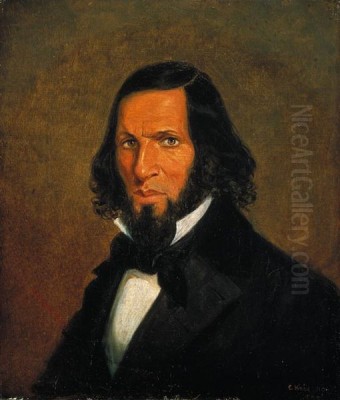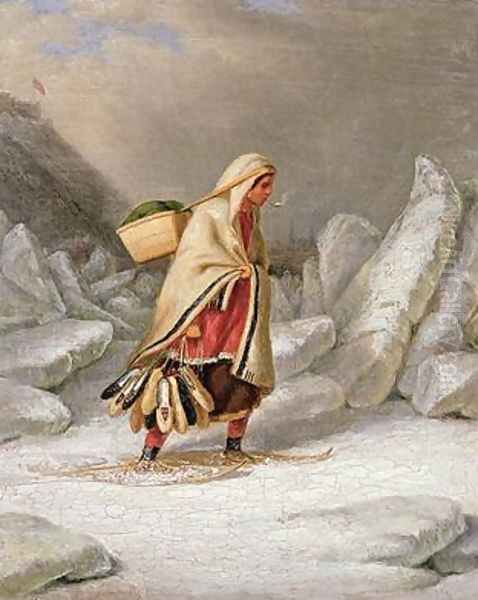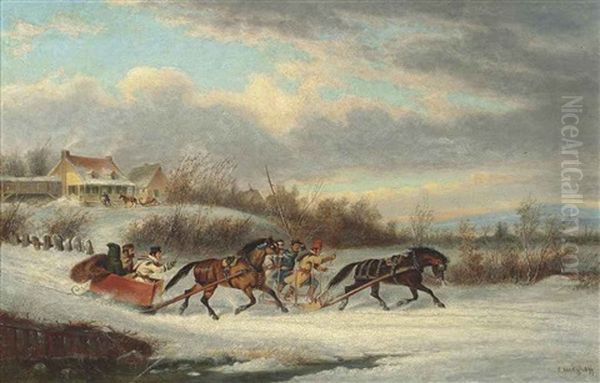
Cornelius David Krieghoff stands as one of the most celebrated and recognizable figures in Canadian art history. Active primarily during the mid-19th century, this Dutch-born painter captured the essence of life in Quebec with a vibrancy and detail that continues to fascinate viewers today. His canvases are windows into a bygone era, depicting the landscapes, people, and daily activities of French Canada and its Indigenous communities. Krieghoff's work, while often romanticized, provides invaluable visual documentation of the social fabric, cultural interactions, and natural environment of Quebec before widespread industrialization and modernization transformed the region. His legacy is not just that of a skilled painter, but also of a cultural recorder whose images have profoundly shaped the popular imagination of 19th-century Canada.
Early Life and Artistic Formation
Cornelius Krieghoff was born in Amsterdam, the Netherlands, on June 19, 1815. His early exposure to the arts came through his family; his father, Conrad Krieghoff, was involved in the arts, possibly as a painter or craftsman himself, having reportedly studied painting in Schweinfurt, Germany, perhaps under Wilhelm Schawitz. This familial connection likely nurtured young Cornelius's artistic inclinations. Seeking formal training, he traveled to Germany, a significant centre for art education at the time.
Around the age of fifteen, in 1830, Krieghoff is said to have entered the prestigious Academy of Fine Arts (Kunstakademie) in Düsseldorf. The Düsseldorf Academy was renowned for its emphasis on detailed realism, narrative clarity, and landscape painting, often imbued with Romantic sensibilities. Artists associated with the Düsseldorf School, such as Andreas Achenbach, Oswald Achenbach, Carl Friedrich Lessing, and Johann Wilhelm Schirmer, were gaining international recognition. While the exact duration and nature of Krieghoff's studies there remain somewhat unclear, the meticulous detail and narrative focus evident in his later work certainly resonate with the school's prevailing style.

Further studies reportedly took place in Schweinfurt, Bavaria, possibly around the age of sixteen, where he is said to have spent about two years refining his skills. Some accounts suggest he studied under Wilhelm von Schadow, a prominent figure associated with the Nazarene movement and later the director of the Düsseldorf Academy, though Schadow's primary tenure in Düsseldorf began later. Regardless of the specific instructors, Krieghoff's European training provided him with a solid technical foundation in drawing, composition, and oil painting techniques, heavily influenced by both German Romanticism and the detailed genre scenes of the Dutch Golden Age masters.
American Interlude: Military Service and Artistic Seeds
Seeking adventure or opportunity, Krieghoff emigrated to the United States, arriving in New York City around 1836. His life took a dramatic turn when, in 1837, he enlisted in the United States Army. This period coincided with the Second Seminole War (1835-1842), a protracted and difficult conflict fought primarily in the Florida territories. Krieghoff served as an artist and possibly a topographical draughtsman, tasked with documenting the campaign.
His military service provided him with firsthand exposure to the North American landscape and its Indigenous inhabitants under challenging circumstances. He created numerous sketches during his time in Florida, capturing scenes of army life, the subtropical environment, and encounters with the Seminole people. Though perhaps not intended as fine art at the time, these sketches proved invaluable later in his career. They served as source material and inspiration for paintings depicting Indigenous figures and dramatic wilderness scenes, lending an air of authenticity, even if filtered through a romantic lens. His military experience, lasting until around 1840, undoubtedly shaped his perspective and provided a unique repository of imagery distinct from his European training.
Arrival in Canada and Establishing a Career
After leaving the US Army, Krieghoff made his way to Canada. He initially settled in Montreal around 1840. It was during this period, or perhaps shortly before, that he met and married Louise Gauthier dit Saint-Germain, a French-Canadian woman from Longueuil, near Montreal. Louise was herself an artist, and her background likely provided Krieghoff with deeper insights into French-Canadian culture and traditions, which would become central themes in his work. The couple started a family, adding personal dimensions to his immersion in Canadian life.
The early years in Montreal presented challenges for Krieghoff as he sought to establish himself as a professional artist. He worked various jobs, including possibly painting signs or decorations, while continuing to develop his portfolio. A significant step came with his participation in exhibitions. In 1847, he exhibited an impressive 48 works at the inaugural exhibition of the Montreal Society of Artists (Salon de la Société des Artistes de Montréal), showcasing his ambition and productivity. This exposure helped raise his profile within the local art community.

Around 1853, Krieghoff and his family relocated to Quebec City, which was then a bustling administrative and cultural centre. This move proved pivotal for his career. Quebec City and its surrounding countryside offered rich subject matter – the historic architecture, the lively St. Lawrence River, the nearby Montmorency Falls, and the traditional life of the habitants (French-Canadian farmers) and the Indigenous communities, particularly the Wendat (Huron) people residing at Lorette (Wendake). He found a receptive market among the British garrison officers, administrators, and affluent merchants who were keen to acquire visual souvenirs of their time in Canada. Auctioneers like John Budden played a role in promoting and selling his work during this period, helping solidify his reputation and financial stability.
The Quebec Years: Themes and Subjects
Krieghoff's most iconic and prolific period unfolded during his time in and around Quebec City. His work from these years provides a rich tapestry of mid-19th-century life in the region, focusing on several key themes.
Depicting the Habitant
Krieghoff became particularly famous for his depictions of French-Canadian rural life, often referred to as "habitant" scenes. He portrayed their daily activities, seasonal rituals, and social gatherings with meticulous detail and often a touch of humour or sentimentality. Winter scenes were a favourite, showcasing sleigh rides, tobogganing parties, habitants returning from the market bundled against the cold, or cozy interiors warmed by stoves. Paintings like The Toll Gate or Habitant Farm exemplify this focus.
He captured the textures of life – the rough-hewn timber of farmhouses, the patterns of homespun cloth (ceinture fléchée), the steam rising from horses' nostrils in the frigid air. While generally sympathetic, his portrayals sometimes leaned towards caricature, emphasizing joviality, simple pleasures, and occasionally boisterous behaviour, which appealed to his predominantly Anglophone patrons' perceptions of French-Canadian culture. These genre scenes, rich in narrative detail, owe a debt to the Dutch and Flemish masters of the 17th century, such as Jan Steen or Adriaen van Ostade, whom Krieghoff admired.
Portraying Indigenous Peoples
Another significant aspect of Krieghoff's oeuvre is his representation of Indigenous peoples. He had established connections with the Mohawk community near Montreal (Kahnawake) and later frequently depicted the Wendat people of Lorette (now Wendake), near Quebec City. His paintings often show Indigenous figures in traditional or adapted clothing, engaged in activities like hunting, fishing, craft-making (snowshoes, baskets), or interacting with settlers. Works like Indian Squaw, Lorette, P. Que. (sometimes titled Indian Woman) or scenes of encampments showcase his interest in their distinct cultures.

Krieghoff's approach was detailed and often presented Indigenous figures with dignity. However, his portrayals were filtered through the prevailing Romantic and ethnographic perspectives of his time. They often emphasized the picturesque or exotic aspects of Indigenous life, sometimes conforming to stereotypes of the "noble savage" or depicting cultures perceived as vanishing. Despite these limitations, his works remain important historical documents, offering glimpses into the appearance, material culture, and perceived activities of Indigenous communities in mid-19th-century Quebec. His friendship with individuals like Gabriel Teoriolen, from whom he reportedly learned about plant-based dyes, suggests a level of direct interaction and observation.
Capturing the Canadian Landscape
The dramatic landscapes of Quebec provided Krieghoff with endless inspiration. He was particularly drawn to the effects of light and atmosphere across the changing seasons. His autumn scenes are renowned for their brilliant colours – fiery reds, oranges, and golds capturing the splendour of the fall foliage along the St. Lawrence River or in the Laurentian Mountains. These works demonstrate his skill in rendering natural detail and his romantic sensibility towards the untamed beauty of the Canadian wilderness.
Winter landscapes were perhaps his most famous specialty. He masterfully depicted the crisp, cold air, the deep snowdrifts, frozen rivers, and the dramatic ice cone that formed annually at Montmorency Falls. His painting Montmorency Falls (in various versions) captures not only the grandeur of the natural wonder but also the human activity surrounding it – sleighs, skaters, and spectators enjoying the winter spectacle. These landscapes combined the detailed observation associated with the Düsseldorf school with a Romantic appreciation for the sublime power and picturesque qualities of nature.
Artistic Style and Technique
Krieghoff's style is characterized by a blend of detailed realism and romantic idealization. His training, particularly the influence of the Düsseldorf School, is evident in his meticulous attention to detail – the texture of fabrics, the rendering of wood grain, the intricacies of snowshoes or sleighs. This precision gives his paintings a documentary quality, making them valuable records of material culture and social customs.
However, Krieghoff was not merely a detached observer. His works are imbued with a narrative and anecdotal quality, often telling a small story or capturing a specific moment in time. He frequently employed vibrant colours, especially in his autumnal landscapes and depictions of colourful clothing like the traditional ceinture fléchée sash worn by habitants. His compositions are typically well-structured, guiding the viewer's eye through the scene.

His approach aligns broadly with Romanticism, emphasizing picturesque scenery, moments of human drama or conviviality, and a certain nostalgia for traditional ways of life. While grounded in observation, his scenes are often carefully composed and slightly idealized, presenting a generally positive and engaging vision of Quebec life that proved highly popular with his audience.
Recognizing the demand for his work, Krieghoff was also an astute entrepreneur. He embraced reproductive technologies, allowing his paintings to be copied as photographs and lithographs. This not only broadened his audience but also provided an additional source of income, making his images widely accessible beyond the circle of wealthy collectors who could afford original oils. This practice, while common later, was relatively innovative for an artist in Canada at that time.
Influences and Contemporaries
Krieghoff's art reflects a confluence of influences. His European training remained fundamental, particularly the legacy of 17th-century Dutch genre painters whose depictions of everyday life resonated with his Canadian subjects. The precision and narrative focus of the Düsseldorf School provided a stylistic framework. During a period spent back in Europe (around 1854-1855), he reportedly studied and copied Old Masters in the Louvre in Paris, possibly receiving guidance from artists like Michel Martin Drolling, further refining his technique.
Within the Canadian context, Krieghoff operated largely independently but was aware of other artists active during the same period. His focus on Indigenous subjects parallels the work of Paul Kane, although Kane's travels were more extensive, and his style often more ethnographic or dramatic. In Quebec, artists like Antoine Plamondon and Théophile Hamel were prominent portraitists and religious painters working in a more formal, academic style. Joseph Légaré, an older contemporary, was known for his landscapes and historical scenes, sometimes depicting disasters or political events with a unique, dramatic flair.
In Montreal, artists like James Duncan and Robert Clow Todd also depicted local scenes and landscapes. Krieghoff's direct interactions included learning from the painter Alfred Holst in Quebec and his friendship with Gabriel Teoriolen. His wife, Louise Gauthier, also an artist, undoubtedly played a role in his life and potentially his art. While direct collaborations might have been limited, Krieghoff's immense popularity set him apart and arguably influenced subsequent generations of genre painters in Canada.
Later Life and Legacy

Krieghoff's success allowed him periods of travel. He returned to Europe several times, including the trip around 1854-55 where he spent time in Paris, Italy, and Germany. He continued to paint prolifically, though he eventually left Quebec City permanently in 1868. He spent some time living in Europe again before settling in Chicago around 1871, perhaps seeking new markets or joining family members.
Tragically, his time in Chicago was short. Cornelius Krieghoff died there on March 8, 1872, at the age of 56. A further loss occurred posthumously: many of the sketches he had brought with him, potentially including valuable early works from his military service and Canadian explorations, are believed to have been destroyed in the Great Chicago Fire of October 1871 (though some sources incorrectly state 1881).
Despite his death, Krieghoff's reputation endured and grew. His paintings became highly sought after by collectors, including prominent figures like Lord Beaverbrook and later, Kenneth Thomson (Lord Thomson of Fleet), whose collections significantly enriched Canadian public galleries. His popularity also led to numerous copies and forgeries, a testament to the strong market demand for his work.
Today, Cornelius Krieghoff is considered a cornerstone figure in 19th-century Canadian art. His works are held in major institutions across Canada, including the National Gallery of Canada, the Art Gallery of Ontario, the Montreal Museum of Fine Arts, and the Musée national des beaux-arts du Québec. His paintings continue to be reproduced widely and are cherished for their detailed, lively, and evocative portrayal of a pivotal era in Canadian history. While modern perspectives acknowledge the romanticized and sometimes stereotypical aspects of his depictions, his contribution to documenting and popularizing Canadian scenes remains undeniable.
Conclusion
Cornelius Krieghoff's art provides a unique and enduring vision of mid-19th-century Quebec. Bridging European artistic traditions with North American subjects, he created a body of work that captured the landscapes, cultures, and daily lives of the region with unprecedented detail and vibrancy. His scenes of habitants navigating snowy landscapes, Indigenous people in forest settings, and the riotous colours of Canadian autumn have become iconic images in the nation's visual lexicon. As a skilled painter, a keen observer (albeit through a romantic lens), and an innovative marketer of his work, Krieghoff achieved remarkable popularity during his lifetime and secured a lasting place as one of Canada's most important historical painters. His canvases remain captivating portals into the world he inhabited and meticulously recorded.